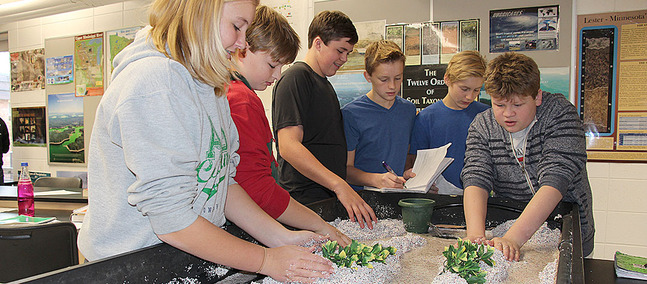Building a river system
Posted on: Dec 12, 2017

It isn’t often that eighth-grade earth science students have an opportunity to watch a river carve new paths through erosion, but a unique tool in Brian Allison’s classroom has changed that.
In mid-November Allison set up a homemade stream table in his room, allowing students to create their own river routes, then watch as the flow of water changed the river bed before their eyes. It was an engaging conclusion to a unit on river processes, which also included a field trip to the Rush River in Henderson the previous month.
“This is just a scaled down version of a natural river system,” said Allison, who used an old door as the base for his table, then constructed the sides with spare wood and finished the box with silicone and a coat of paint. The box is filled with purpose-made plastic grains that don’t discolor the water like natural sand, but show the same process of erosion.
During a river process lab, about 30 gallons of water in a reservoir are pumped to the head of the table, which gradually slants downward back toward the reservoir. Then gravity takes over and river beds of the students’ design begin the process of evolving.
“They’re making observations of how a river changes over time, how it starts and tends to flow straight, like young rivers do, and then given enough time it will start to meander and develop curves like the Crow or the Minnesota or the Mississippi,” said Allison.
The idea for the stream table came from a conference Allison attended, where a company from Illinois advertised them for $1,500.
“They do great work with earth science and river systems, but $1,500 was too much for us,” he said, adding that his homemade table, including the pump, cost less than $50 to build. The expensive part was the plastic fill, which came in three 50-pound boxes from a manufacturer in Connecticut. The boxes were about $50 each, but the shipping cost was triple that due to the weight.
Allison has included his stream table in the unit for about the past six years, and said it has added a fun, interactive element to the lessons.
“It’s made it more enjoyable, I think, because they can see it. It’s not just an outdoor topic where you have to go visit a river. This brings a river to them,” Allison said
Students experiment by replicating spring snow melt, creating a dam and more.
“For them it’s like playtime, but they’re learning,” said Allison. “They try to modify it as much as they can. Sometimes it works and sometimes the river has its own mind and does its own thing.”
River visits
In October students continued a decade-long practice of visiting the Minnesota River valley, as well as Rush River County Park near Henderson, to see real rivers in action. Why not simply visit the Crow in Delano?
“We go there because the Minnesota River, when it was formed, cut so deep,” said Allison. “It cut through three layers of glacial fill. When we go to the Rush River County Park, we can access the remnants of those glacial till layers. The Crow is only cut into the top layer of glacial till. There is no base level that’s low enough for what we need.”
There is also the simple fact that wonders of nature can often go overlooked in the hustle of everyday life.
“We make a stop on the Minnesota River to see how big that river valley is,” said Allison. “Most people here aren’t aware of it, or as they go through it they’re listening to music and just aren’t paying attention to what is around them.”
Thanks to some active learning both in the classroom and abroad, lack of awareness in regard to rivers and their actions should not be much of an issue for Delano students in the years ahead.